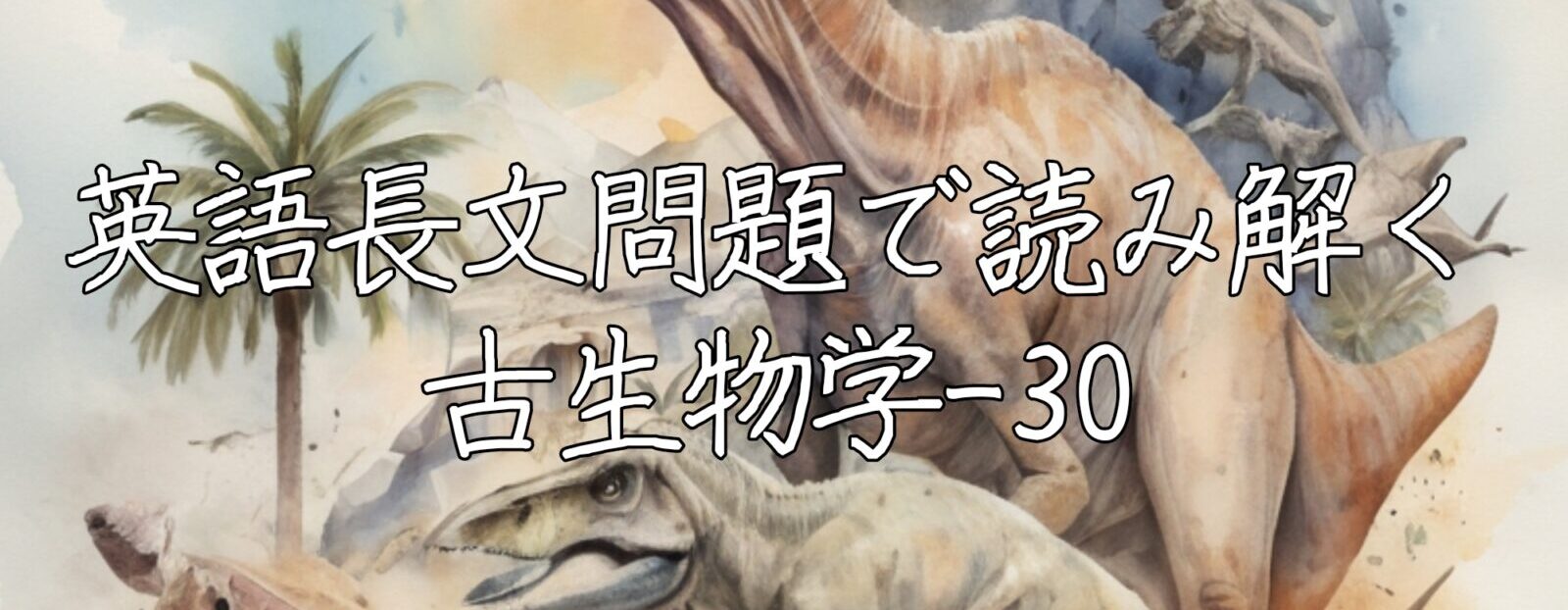英検2級レベルの英語長文問題を読み解きながら、古生物学の基本的な知識を身につけることが出来る問題集をkindleにて出版しました!
英検やTOEFLなど、英語にまつわる様々な検定試験対策に最適な長文問題集です!
専門性の高い文章を読みながら、知識と英語力を高めることのできる一冊になっています。

英語長文問題で読み解く古生物学-30: 古生物学の重要テーマを英語で読み解く 英語長文問題で読み解く学問シリーズ
これまでに発売した英語の長文問題集の一覧はコチラから!
英語長文で読み解く古生物学-30 の中身を公開!
以下、どんな内容になっているのかを公開します!
目次
はじめに
1.化石 – 古代生物の遺骸や痕跡が地層中に保存されたもの。
2.層位学 – 地層の形成過程とその順序を研究する学問。
3.古環境学 – 過去の環境や気候条件を研究する学問。
4.古生態学 – 古代生物の生態系や生態関係を研究する学問。
5.古生物相 – 特定の時代や地域に存在した生物群。
6.地質時代 – 地球の歴史を年代順に分けた時間スケール。
7.古生物 – 化石を通じて古代生物を研究する学問。
8.系統発生 – 生物の進化的な系統関係。
9.パンゲア – かつて存在した超大陸。
10.ゴンドワナ – パンゲアが分裂して形成された南半球の超大陸。
11.ローラシア – パンゲアが分裂して形成された北半球の超大陸。
12.中生代 – 恐竜が繁栄した時代。
13.古生代 – 生命が海から陸へ進出した時代。
14.新生代 – 現在の動植物が繁栄する時代。
15.三畳紀 – 中生代の初期。
16.ジュラ紀 – 恐竜が繁栄した中生代の中期。
17.白亜紀 – 恐竜が絶滅した中生代の最後の時代。
18.カンブリア紀 – 古生代の初期で、多くの動物門が出現した時代。
19.オルドビス紀 – 古生代の第二期。
20.シルル紀 – 古生代の第三期。
21.デボン紀 – 古生代の第四期。
22.石炭紀 – 古生代の第五期。
23.ペルム紀 – 古生代の最終期。
24.氷期 – 地球が寒冷化し、氷床が拡大した時期。
25.古海洋学 – 過去の海洋の状態や変動を研究する学問。
26.古気候学 – 過去の気候を研究する学問。
27.古生物学的再構築 – 化石を基に古代生物や環境を再現すること。
28.地球史 – 地球の形成から現在までの歴史。
29.古生物の分類学 – 古生物の分類を行う学問。
30.古生物の遺伝学 – 古生物の遺伝情報を研究する学問。
1.化石 – 古代生物の遺骸や痕跡が地層中に保存されたもの。
The Fascinating World of Fossils: Windows to Earth’s Past
Fossils are remarkable remnants of ancient life that provide invaluable insights into the history of our planet. These preserved traces of organisms that lived millions of years ago serve as a gateway to understanding Earth’s past ecosystems, climates, and the evolution of life itself. Paleontologists, scientists who study fossils, use these ancient clues to piece together the puzzle of our planet’s biological heritage.
The process of fossilization is a rare and complex phenomenon. Most organisms decompose quickly after death, leaving no lasting trace. However, under specific conditions, the remains of plants and animals can be preserved in rock formations. This preservation can occur through various methods, such as permineralization, where minerals replace organic matter, or impression fossils, where an imprint of the organism is left in sediment that later hardens into rock.
One of the most famous examples of fossilization is the preservation of dinosaur bones. These ancient reptiles ruled the Earth for over 160 million years, and their fossilized remains have captivated both scientists and the public alike. The discovery of complete dinosaur skeletons, such as the Tyrannosaurus rex nicknamed “Sue” found in South Dakota, USA, has revolutionized our understanding of these prehistoric creatures. Sue’s well-preserved bones have allowed researchers to study the dinosaur’s anatomy, growth patterns, and even potential diseases.
Fossils are not limited to bones, however. Trace fossils, such as footprints, burrows, and even coprolites (fossilized feces), provide valuable information about animal behavior and ancient environments. For instance, dinosaur trackways discovered in various parts of the world have helped paleontologists understand how these animals moved and interacted with their surroundings. In some cases, these tracks have revealed previously unknown species or behaviors that skeletal remains alone could not show.
The study of microfossils, tiny remains of organisms like foraminifera or pollen grains, is another crucial aspect of paleontology. These microscopic fossils can be found in great abundance and are particularly useful for dating rock layers and reconstructing past climates. By analyzing the types and quantities of microfossils present in sedimentary rocks, scientists can infer information about ancient ocean temperatures, atmospheric composition, and even the spread of plants across continents.
One of the most exciting developments in the field of paleontology in recent years has been the discovery of exceptionally well-preserved fossils that include soft tissues. The Burgess Shale in Canada, for example, contains an array of fossilized marine invertebrates from the Cambrian period, approximately 508 million years ago. These fossils provide an unprecedented glimpse into the diversity of early animal life, including many soft-bodied organisms that would not typically fossilize under normal conditions.
Amber, fossilized tree resin, is another source of extraordinarily well-preserved specimens. Insects, small vertebrates, and even feathers have been found encased in amber, sometimes in near-perfect condition. These “time capsules” allow scientists to study ancient organisms in remarkable detail, often preserving colors, textures, and even cellular structures that would otherwise be lost to time.
The study of fossils extends beyond pure scientific interest; it has practical applications as well. Fossil fuels, such as coal, oil, and natural gas, are derived from the remains of ancient organisms buried and transformed over millions of years. Understanding the distribution and formation of these resources is crucial for energy exploration and environmental studies.
Moreover, fossils play a vital role in our understanding of climate change. By studying the types of plants and animals that lived in different periods, scientists can reconstruct past climates and use this information to model future climate scenarios. This research is essential for predicting and mitigating the effects of current and future climate change.
As technology advances, new methods for studying fossils continue to emerge. Techniques such as CT scanning and 3D printing allow researchers to examine internal structures of fossils without damaging the specimens. These non-invasive approaches have led to groundbreaking discoveries about the anatomy and evolution of various species.
In conclusion, fossils are much more than just interesting rocks or museum curiosities. They are invaluable tools for understanding the history of life on Earth, past climates, and the processes that have shaped our planet over millions of years. As we continue to unearth new specimens and develop innovative research methods, the field of paleontology promises to reveal even more secrets about our planet’s fascinating past.
注釈
- Paleontologists (古生物学者): Scientists who study fossils and prehistoric life.
- Fossilization (化石化): The process by which remains, impressions, or traces of living things are preserved in rock.
- Permineralization (置換): A type of fossilization where minerals replace organic matter.
- Impression fossils (印象化石): Fossils formed when an organism leaves an imprint in sediment that later hardens.
- Tyrannosaurus rex (ティラノサウルス・レックス): A large carnivorous dinosaur from the late Cretaceous period.
- Trace fossils (生痕化石): Fossils that preserve evidence of animal activity, such as footprints or burrows.
- Coprolites (糞石): Fossilized feces.
- Microfossils (微化石): Microscopic fossils, often used for dating rock layers and studying past environments.
- Foraminifera (有孔虫): Single-celled organisms with shells, commonly found as microfossils.
- Burgess Shale (バージェス頁岩): A famous fossil site in Canada known for its well-preserved Cambrian-era fossils.
- Amber (琥珀): Fossilized tree resin that often preserves insects and small organisms.
- CT scanning (CTスキャン): A medical imaging technique used to examine internal structures of fossils.
設問
- What is the primary role of paleontologists?
a) To study modern ecosystems
b) To analyze fossil fuels
c) To examine fossils and prehistoric life
d) To predict future climate changes - Which of the following is NOT mentioned as a method of fossilization?
a) Permineralization
b) Crystallization
c) Impression fossils
d) Amber preservation - Why is the Tyrannosaurus rex nicknamed “Sue” significant?
a) It was the largest T. rex ever found
b) It provided valuable information about dinosaur anatomy and growth
c) It was discovered in multiple pieces across different states
d) It showed evidence of interspecies communication - What information can trace fossils provide?
a) The color of ancient animals
b) The diet of prehistoric plants
c) Animal behavior and ancient environments
d) The age of the Earth - How are microfossils particularly useful in paleontology?
a) They provide DNA samples of ancient organisms
b) They help in dating rock layers and reconstructing past climates
c) They show the evolution of large mammals
d) They are easy to extract from any type of rock - What makes the Burgess Shale fossils exceptional?
a) They contain dinosaur bones
b) They are the oldest fossils ever found
c) They preserve soft-bodied organisms from the Cambrian period
d) They show evidence of the first human ancestors - Which of the following is true about amber fossils?
a) They only preserve plant material
b) They can sometimes preserve colors and textures of ancient organisms
c) They are formed from volcanic ash
d) They are primarily used to study dinosaurs - How do fossils contribute to our understanding of climate change?
a) They directly measure ancient temperature and CO2 levels
b) They provide information about past climates through preserved organisms
c) They show the effects of human activity on prehistoric environments
d) They can predict exact future weather patterns - What new technology is mentioned as being useful in studying fossils?
a) Radiocarbon dating
b) Satellite imaging
c) CT scanning and 3D printing
d) Genetic sequencing - According to the passage, why are fossils important beyond scientific interest?
a) They are valuable collectibles
b) They can be used to create jewelry
c) They help in energy exploration and environmental studies
d) They provide inspiration for science fiction stories
解答・解説
- 古生物学者の主な役割は何ですか?
a) 現代の生態系を研究すること
b) 化石燃料を分析すること
c) 化石と先史時代の生命を調べること
d) 将来の気候変動を予測すること
答え:c) 化石と先史時代の生命を調べること
説明:本文では、古生物学者が「化石を研究する科学者」と定義されています。彼らは古代の生命の痕跡を使って地球の生物学的遺産を理解しようとしています。
- 以下のうち、化石化の方法として言及されていないものはどれですか?
a) 置換
b) 結晶化
c) 印象化石
d) 琥珀による保存
答え:b) 結晶化
説明:本文では、置換(permineralization)、印象化石、琥珀による保存が化石化の方法として言及されていますが、結晶化については触れられていません。
- ティラノサウルス・レックスの「スー」というニックネームが重要なのはなぜですか?
a) 今まで発見された中で最大のT.レックスだったから
b) 恐竜の解剖学と成長に関する貴重な情報を提供したから
c) 複数の州にまたがって発見されたから
d) 種間のコミュニケーションの証拠を示したから
答え:b) 恐竜の解剖学と成長に関する貴重な情報を提供したから
説明:本文によると、「スー」の保存状態の良い骨は、研究者が恐竜の解剖学、成長パターン、さらには潜在的な病気を研究することを可能にしました。
- 生痕化石はどのような情報を提供できますか?
a) 古代の動物の色
b) 先史時代の植物の食生活
c) 動物の行動と古代の環境
d) 地球の年齢
答え:c) 動物の行動と古代の環境
説明:本文では、足跡や巣穴などの生痕化石が、動物の行動や古代の環境に関する貴重な情報を提供すると述べられています。
- 古生物学において、微化石が特に有用なのはなぜですか?
a) 古代生物のDNAサンプルを提供するから
b) 岩層の年代決定と過去の気候の再構築に役立つから
c) 大型哺乳類の進化を示すから
d) あらゆる種類の岩から簡単に抽出できるから
答え:b) 岩層の年代決定と過去の気候の再構築に役立つから
説明:本文によると、微化石は「岩層の年代決定や過去の気候の再構築に特に有用」であると述べられています。
と、このような感じで、30問の長文問題が一冊にまとまっております!
古生物学の重要テーマ、30問あります!
目次にもあるように、30個の古生物学にまつわる重要テーマやキーワードを使い、長文問題を作りました。
英語力を向上させたい、かつ、古生物学の知識を得たい人にとって、最適な長文問題集となっております。
英語レベルは英検2級を目指している人にとって丁度いい塩梅。
英検に限らず、専門性の高い英語長文を読む必要のあるTOEFL対策にもなる長文問題集になっています。
タイパを重視して、古生物学の知識を得つつ、英語の読解力を向上させたい人は、ぜひ活用してみてください。

英語長文問題で読み解く古生物学-30: 古生物学の重要テーマを英語で読み解く 英語長文問題で読み解く学問シリーズ
これまでに発売した英語の長文問題集の一覧はコチラから!
#Kindle出版 #Kindle電子書籍 #Kindle本 #英語 #英語長文問題 #英検対策 #TOEFL対策 #恐竜 #古生物学 #英語学習







コメント